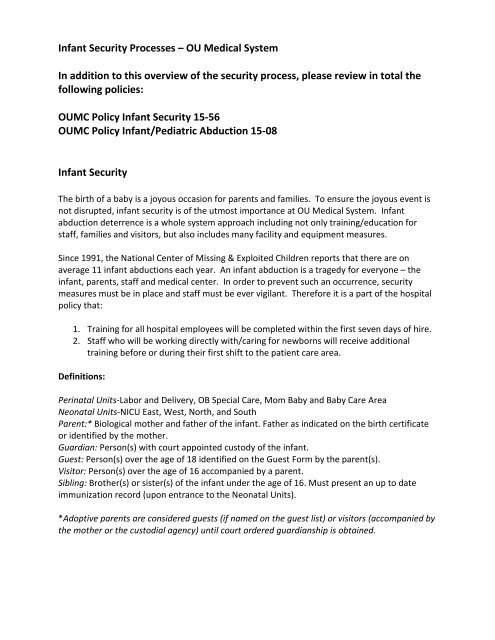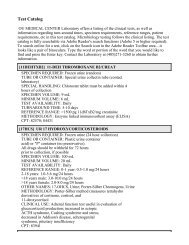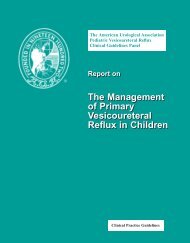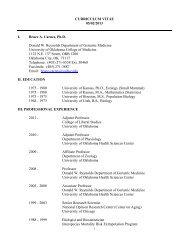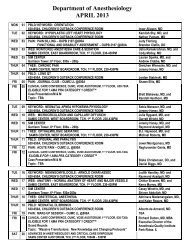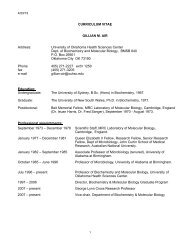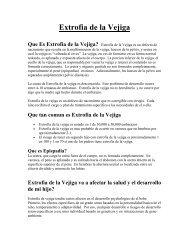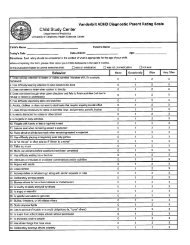Infant Security Processes â OU Medical System In ... - OU Medicine
Infant Security Processes â OU Medical System In ... - OU Medicine
Infant Security Processes â OU Medical System In ... - OU Medicine
You also want an ePaper? Increase the reach of your titles
YUMPU automatically turns print PDFs into web optimized ePapers that Google loves.
<strong><strong>In</strong>fant</strong> <strong>Security</strong> <strong>Processes</strong> – <strong>OU</strong> <strong>Medical</strong> <strong>System</strong><br />
<strong>In</strong> addition to this overview of the security process, please review in total the<br />
following policies:<br />
<strong>OU</strong>MC Policy <strong><strong>In</strong>fant</strong> <strong>Security</strong> 15-56<br />
<strong>OU</strong>MC Policy <strong><strong>In</strong>fant</strong>/Pediatric Abduction 15-08<br />
<strong><strong>In</strong>fant</strong> <strong>Security</strong><br />
The birth of a baby is a joyous occasion for parents and families. To ensure the joyous event is<br />
not disrupted, infant security is of the utmost importance at <strong>OU</strong> <strong>Medical</strong> <strong>System</strong>. <strong><strong>In</strong>fant</strong><br />
abduction deterrence is a whole system approach including not only training/education for<br />
staff, families and visitors, but also includes many facility and equipment measures.<br />
Since 1991, the National Center of Missing & Exploited Children reports that there are on<br />
average 11 infant abductions each year. An infant abduction is a tragedy for everyone – the<br />
infant, parents, staff and medical center. <strong>In</strong> order to prevent such an occurrence, security<br />
measures must be in place and staff must be ever vigilant. Therefore it is a part of the hospital<br />
policy that:<br />
1. Training for all hospital employees will be completed within the first seven days of hire.<br />
2. Staff who will be working directly with/caring for newborns will receive additional<br />
training before or during their first shift to the patient care area.<br />
Definitions:<br />
Perinatal Units-Labor and Delivery, OB Special Care, Mom Baby and Baby Care Area<br />
Neonatal Units-NICU East, West, North, and South<br />
Parent:* Biological mother and father of the infant. Father as indicated on the birth certificate<br />
or identified by the mother.<br />
Guardian: Person(s) with court appointed custody of the infant.<br />
Guest: Person(s) over the age of 18 identified on the Guest Form by the parent(s).<br />
Visitor: Person(s) over the age of 16 accompanied by a parent.<br />
Sibling: Brother(s) or sister(s) of the infant under the age of 16. Must present an up to date<br />
immunization record (upon entrance to the Neonatal Units).<br />
*Adoptive parents are considered guests (if named on the guest list) or visitors (accompanied by<br />
the mother or the custodial agency) until court ordered guardianship is obtained.
What You Should Know To Prevent An <strong><strong>In</strong>fant</strong> Abduction!<br />
What safety measures are currently used (or will be coming soon) to prevent an infant<br />
abduction?<br />
• Distinctive badges for perinatal and neonatal unit staff, including agency and traveling<br />
nurses<br />
• Distinctive badges for hospital-privileged Perinatal and Neonatal physicians and<br />
Advanced Practice Clinicians<br />
• Perinatal and Neonatal unique scrubs that are easy to distinguish from a distance<br />
• Limited access to perinatal and neonatal care units using card swipe access<br />
• Hospital employees presenting on the units must wear a hospital-issued photo ID badge<br />
• Students, contracted staff and non-healthcare service providers presenting on the units<br />
will wear accompanying school/company ID badge and a temporary unit-issued badge<br />
• All visitors will be greeted upon entry and validated to be on the care area<br />
• Random <strong>Security</strong> Checks<br />
• “Code Pink” and <strong><strong>In</strong>fant</strong> <strong>Security</strong> Plans<br />
• Staff vigilance and prompt action<br />
• Newborn foot-prints and photographs<br />
• Application of mother/father/baby bands and use of Electronic <strong><strong>In</strong>fant</strong> <strong>Security</strong> Devices<br />
• Mothers/primary caregivers provide the hospital an “approved” guest list<br />
How are infants transported in the facility?<br />
• <strong><strong>In</strong>fant</strong>s are only transported in bassinets – never hand carried unless in the mother’s<br />
arms while riding in a wheelchair or carrier<br />
• <strong><strong>In</strong>fant</strong>s are always discharged accompanied by a nurse<br />
What are your responsibilities in maintaining <strong><strong>In</strong>fant</strong> <strong>Security</strong>?<br />
• Wear your name badge at all times when on duty – badge compliance will be strictly<br />
enforced<br />
• Make sure others do not enter with you as you open/enter through a secure door<br />
• Be alert to unusual behavior<br />
• Report ANY suspicious individuals to police/security<br />
• Stop and question any suspicious individuals carrying an infant bag, package, backpack,<br />
etc…<br />
o “May I help you?” is the most effective means of stopping and later identifying a<br />
potential abductor<br />
• Call for “Code Pink” immediately if you are unable to stop and question a suspicious<br />
person. Dial 14911 on the downtown campus and 444 on the Edmond campus<br />
• Keep a suspicious individual in sight while assuring your own safety<br />
Prevention is the best defense against infant abductions.<br />
Maintain your vigilance at all times.
Now you are asking, what does a suspicious person look like?<br />
It is someone who may exhibit one or more of the following characteristics:<br />
• Makes repeated visits “just to see” the babies<br />
• Takes uniforms, scrubs, or other means of hospital identification as well as<br />
stethoscopes, pagers, etc…<br />
• Loiters on the floors where the perinatal and neonatal units are located and around the<br />
doors<br />
• Asks questions about the floor plans, location of nursery, procedures, etc.<br />
o For example – “Where do the stairwells lead?” or “Do babies stay with mother at<br />
all times?”<br />
• Carries a large package from the care area (e.g. gym bag), particularly if the person is<br />
“cradling” or “talking” to the bag<br />
• Carries an infant in a corridor instead of a bassinet<br />
• Walks out of the hospital with an infant rather than riding in a wheelchair with a staff<br />
member or volunteer escort<br />
The Abductor – Profile from the National Center for Missing & Exploited Children:<br />
• Is usually female of “childbearing” age (range now 12 to 53) and often overweight.<br />
• Is most likely compulsive; most often relies on manipulation, lying, and deception.<br />
• Frequently indicates she has lost a baby or is incapable of having one.<br />
• Is often married or cohabitating; companion’s desire for a child or the abductor’s desire<br />
to provide her companion with “his” child may be the motivation for the abduction.<br />
• Usually lives in the community where the abduction takes place.<br />
• Frequently initially visits nursery and maternity units at more than one healthcare<br />
facility prior to the abduction; asks detailed questions about procedures and the<br />
maternity floor layout; frequently uses a fire-exit stairwell for her escape; and may also<br />
try to abduct from the home setting.<br />
• Usually plans the abduction, but does not necessarily target a specific infant; frequently<br />
seizes any opportunity present.<br />
• Frequently impersonates a nurse or other allied healthcare personnel.<br />
• Often becomes familiar with healthcare staff members, staff members work routines,<br />
and victim parents.<br />
• Demonstrates a capability to provide “good” care to the baby once the abduction<br />
occurs.<br />
There is no guarantee an infant abductor will fit this description. This is only a profile. An<br />
infant abductor can be of ANY sex, age, or description including.. a hospital employee.<br />
Thank you for your time and attention to this<br />
important topic!


